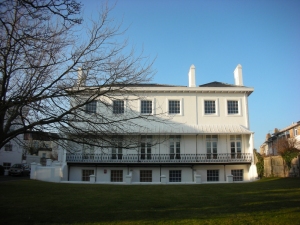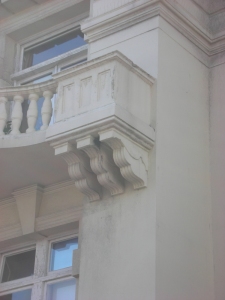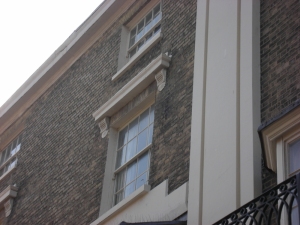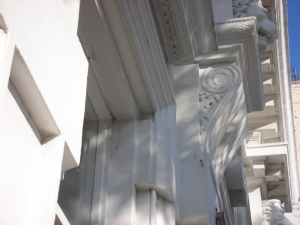When is an arch not an arch?
There is, in the rarefied world of architecture, an awful lot of terminology. From your lierne vaults to your pendentives, we archibuffs have come up with some fairly obscure names. Then again, they’re usually for fairly obscure things, so maybe it doesn’t matter that much.
One architectural device that we’ve been reasonably clear about is the humble arch. Yes, OK, we have fancy derivations (the three-centred arch, the Tudor arch, the parabolic arch, even the flat arch) but they all basically imply that, well – there’s some curving going on (yeah, I know the flat arch sounds like it’s, well, flat. Which it is. But it’s still an arch. Alright – I’ll put in on the list. See future post). This is an arch near me:
Isn’t that nice? And we all know what’s going on here. The stones around the arch are wedge-shaped and each one passes its downward force onto its neighbour. Very clever. The Romans were the first people to do a lot with arches, and they stole everything they knew from the Mesopotamians.
What’s this got to do with railway stations? Funny you should ask. Dan Cruikshank – recipient of the first and hitherto only Member of the Order of Fine Pedimentarians – once made a TV show in which he raised (no doubt with a quasi-orgasmic tone) some big lumps of stone from the bottom of the Prescott Channel. I realise that I could make some “Two Slabs” jokes, but I shan’t. Prescott? Two slabs? Please yourselves. These bits of rock were parts of the original Euston Arch, cruelly torn down by evil ’60s developers. Arch. Railways. Getting there.
These days, you’re not a London terminus unless you are willing to be subjected to a makeover. This will involve:
- Your recent bits being removed
- Your old bits being tarted up
- Your concourse being made to look like an airport terminal
- A statue of a literary figure being placed nearby
- Ridiculously priced apartments being built on you
- An attempt to alter your primary function to be a “retail and leisure destination”
At King’s Cross (a much better station than St Pancras; all those weak trefoil-arched windows! And that godawful roof. Well, the problem really is the intermediate floor. You wouldn’t put a ceiling half way up Gloucester Cathedral, would you? Tsk.) they’re putting in an enormous fan vault, which is quite clever, and thankfully removing the desperately inappropriate existing concourse to open up the square outside.
But at Euston they’ve really got a job on their hands. This is a station entirely rebuilt in the sixties – not exactly a time whose architecture has ever got over the Marmite dilemma. So they’re giving it another go. What they’re planning is of course a complete monstrosity. an exercise in site-suffocation and shopping-mall banality. But they are at least seriously considering the reinstatement of the Arch.
Which is great news. A silly-big arch right in the middle of London, celebrating (as current architecture seems unable to do) the wonders of mass transit. I mean, it’s really way too big. It’s just ridiculous. This is – thanks to the good folk at Wikipedia – what it would apparently look like were it to be put back:

I take issue with only one thing. It isn’t an arch. Look at it – where are the curvy bits? It’s not even a flat arch – whatever one of those is.
So why is it called Euston Arch? Obviously the misassociation is with triumphal arches. There’s a very tasteful one of those in Worthing, of which I am sure you are familiar, as well as slightly older ones in Rome. The Romans built these to commemorate particular victories and traditionally they’d have friezes and statues and the like to tell the story of said war. And – because men have, throughout the ages, liked to put up great big humps of stone whenever they’ve killed thousands of people – this has remained the predominant form of Big Classical Stone Thing You Can Walk Under That Isn’t A Proper Building throughout Europe.
The one major exception is the Brandenburg Gate. Clearly that’s a big stone thing, but it does rather prove the rule about arches – the Gate was built to represent peace (Victory – the goddess in the chariot – originally carried an olive branch rather than the later iron cross we see today). And of course it’s correctly called a gate, not an arch. The clue’s in the name, people.
Great, so that’s sorted – we should call the Euston Arch the Euston Gate, right? Well, almost. The thing is that archibuffs, as I may have mentioned already, do have this particular tendency. And the ancient Greeks had a lovely language. So, once they’ve reinstated this giant, freestanding Doric-order portico, with its metopes and triglyphs and guttae and stylobates, you’ll be able to look up and say, “ah. The lovely Euston Propylaeum.”






